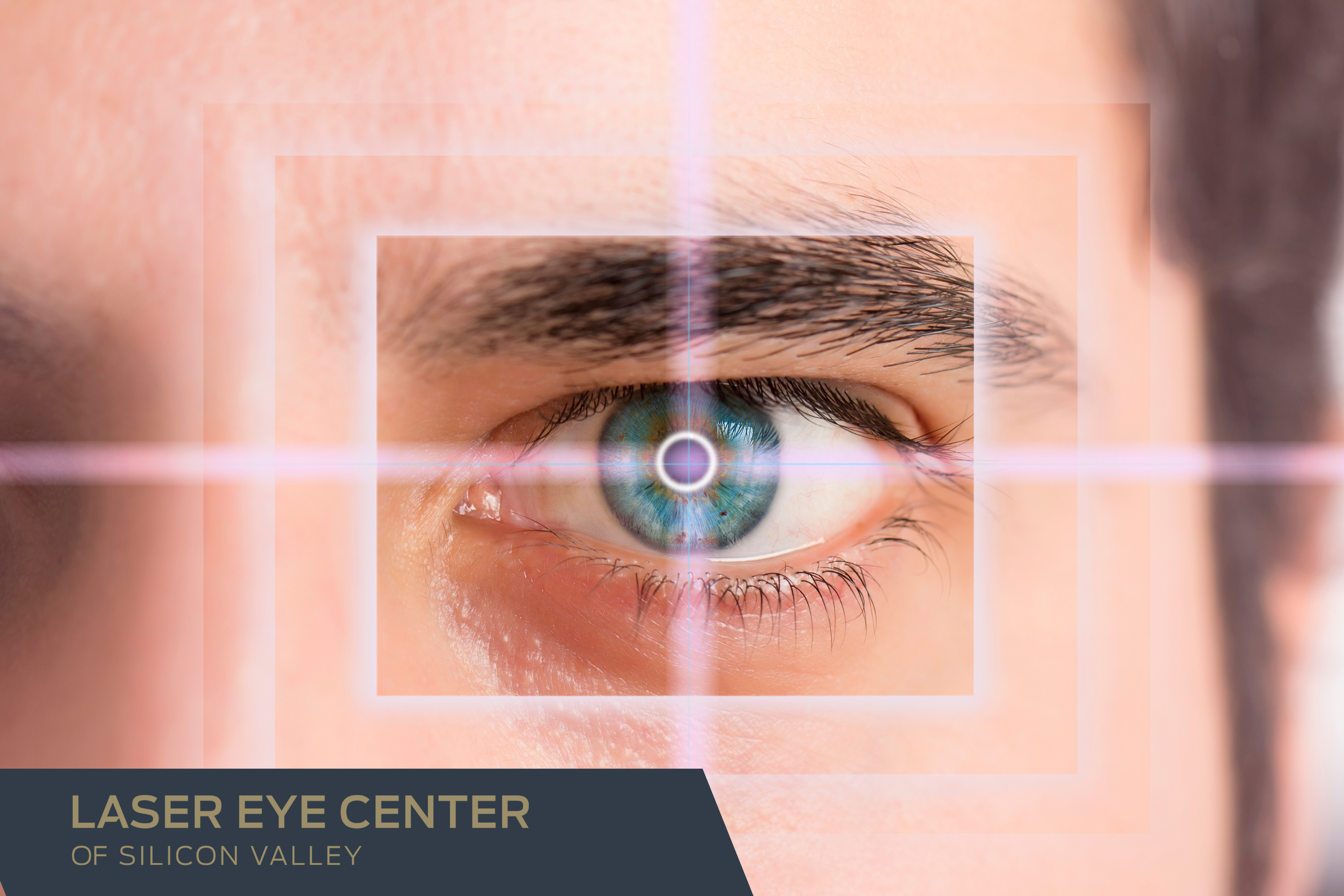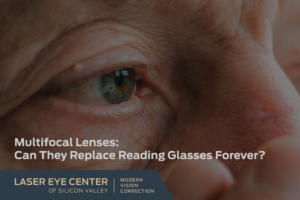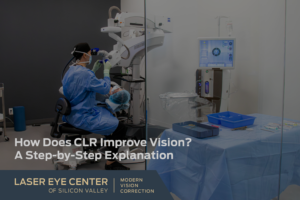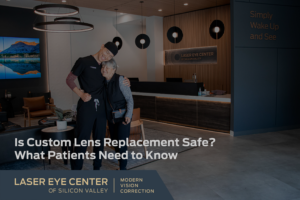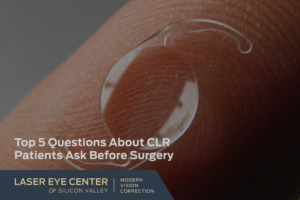Understanding modern vision correction procedures like EVO ICL and CLR can be a game-changer for individuals seeking freedom from glasses and contacts.
While LASIK improves vision by changing the shape of the cornea (the front of the eye), Laser Eye Center of Silicon Valley performs lens-based procedures that may be a better option than LASIK for certain patients. CLR focuses on replacing the aging lens to restore clear vision without dependence on corrective eyewear, while EVO ICL provides an insertable contact lens (ICL) to correct common vision issues like myopia (nearsightedness) and astigmatism.
In this comprehensive guide, we delve into the differences between these procedures, candidacy criteria, the process involved, post-operative care, and other essential information to assist those considering vision correction options.
EVO ICL: A New Era in Modern Vision Correction
What is EVO ICL?
EVO ICL stands for “Evolutionary Implantable Collamer Lens,” or as we like to explain it to patients: Insertable Contact Lens.
The procedure is a type of eye surgery designed to improve vision by gently inserting a lens just below the surface of the eye.
Unlike traditional contact lenses that sit on the surface of the eye, the EVO ICL is placed between the iris and the natural lens, working with the eye’s natural optics to correct vision. The biocompatible lens is specifically tailored to match the patient’s prescription, ensuring a personalized solution to vision correction.
This procedure is particularly beneficial for individuals under 45 who want clear vision without glasses or external contact lenses.
Since EVO ICL is minimally invasive and does not permanently alter the structure of the eye, it is a reversible option, which adds an extra layer of reassurance for those considering the procedure.
EVO ICL vs. Traditional Laser Vision Correction
EVO ICL differs from traditional laser eye surgery in several key ways.
Traditional procedures like LASIK involve reshaping the cornea to correct vision, which is permanent. EVO ICL, on the other hand, does not alter the cornea.
Instead, an implanted contact lens is added to enhance the eye’s ability to focus images clearly. This means that EVO ICL can be an option even for those with thin corneas or high prescriptions who are not candidates for LASIK.
Additionally, our experience as the leading practice in Northern California (as measured by the number of patients who choose to have EVO ICL at our center) has shown that the procedure reduces the risk of dry eye for patients who experienced this due to long-term contact lens wear or their unique anatomy.
Recovery time for EVO ICL is typically rapid, with many patients experiencing improved vision almost immediately after the procedure. The reversible nature of EVO ICL also means that it can be removed or updated if needed, providing a flexibility that traditional laser eye surgeries do not offer.
This makes EVO ICL a compelling option for those seeking a less invasive and adjustable vision correction solution.
The EVO ICL Procedure: What to Expect
Traditional procedures like LASIK involve reshaping the cornea to correct vision, which is permanent. EVO ICL, on the other hand, does not alter the cornea.
Instead, an implanted contact lens is added to enhance the eye’s ability to focus images clearly. This means that EVO ICL can be an option even for those with thin corneas or high prescriptions who are not candidates for LASIK.
Additionally, our experience as the leading practice in Northern California (as measured by the number of patients who choose to have EVO ICL at our center) has shown that the procedure reduces the risk of dry eye for patients who experienced this due to long-term contact lens wear or their unique anatomy.
Recovery time for EVO ICL is typically rapid, with many patients experiencing improved vision almost immediately after the procedure. The reversible nature of EVO ICL also means that it can be removed or updated if needed, providing a flexibility that traditional laser eye surgeries do not offer.
This makes EVO ICL a compelling option for those seeking a less invasive and adjustable vision correction solution.
The EVO ICL Procedure: What to Expect
Undergoing the EVO ICL procedure starts with a thorough eye examination and consultation to ensure you are a good candidate.
Once we know your eyes are healthy, we can schedule your procedure date and order the lenses, which are customized to the prescription of each patient to fix nearsightedness and, if indicated, astigmatism.
The procedure itself is quick, typically taking only about 20 to 30 minutes for both eyes. We perform all our procedures in our state-of-the-art office surgery center. Before the surgery, you’ll receive numbing drops to ensure comfort. The surgeon then makes a small incision and inserts the EVO ICL through it, positioning the lens behind the iris and in front of the natural lens.
Patients are awake during the procedure and typically having a conversation with the surgeon during the procedure. After the procedure, we have patients sit and rest for about 20 minutes, and then our surgeon will do a quick check in the exam room to make sure everything is according to plan.
Right then, many patients can see well enough to pass the driver’s exam, regardless of how “bad” their vision was before the procedure.
However, we instruct patients to go home and rest for the balance of the day and look forward to seeing them the next day for their first post-procedure appointment. The recovery period is relatively short, with many people able to resume their normal activities within a day or two.
NOTE: It’s important to follow the post-operative care instructions provided by your surgeon, which include using prescribed eye drops to prevent infection and attending follow-up appointments to monitor healing and vision improvements.
CLR: Eliminating the Need for Bifocals and Readers
Understanding Custom Lens Replacement (CLR)
Custom Lens Replacement (CLR), also known as Refractive Lens Exchange (RLE), is a procedure that replaces the eye’s natural lens with a synthetic one to correct vision impairments, particularly presbyopia and cataracts.
This procedure is similar to cataract surgery—the most commonly performed surgical procedure worldwide that has been done for more than 60 years. CLR similarly replaces the natural lens that clouds with age, but it can be performed before the full impact of the aging process is felt. It can eliminate dependence on bifocals or reading glasses for patients aged 45 and up.
The great thing about CLR is that it allows you to have the best vision you can as you age, and it ensures that you will not develop cataracts in the future.
CLR can be an effective solution for those who may not be suitable candidates for laser-based corrective surgeries. It is also a permanent solution for patients who have previously had laser vision correction.
While LASIK provides excellent distance vision because the laser reshapes the cornea, it has no impact on the eye’s natural lens, which changes as we get older. Indeed, many of our CLR patients had LASIK with us 10-20 years ago. They enjoyed seeing clearly for years and have taken the step to continue life without glasses by addressing the aging component of their eyes.
During the procedure, the surgeon removes the natural lens of the eye and replaces it with a custom intraocular lens (IOL) implant. The IOL is selected based on the individual’s specific vision needs and can correct for distance, intermediate, and near vision.
There are numerous IOL technologies available, and our surgeons use their expertise along with the data from your Advanced Vision AnalysisSM to select the IOL for each eye that will allow the patient to achieve their best possible outcome.
Technologies include the Light Adjustable Lens (LAL), Multifocal, Extended Depth of Focus (EDOF), Accommodating and Monofocal implants. Each of them plays a role in CLR. All IOLs are thoroughly studied and approved by the FDA before they are allowed to be used by surgeons in the United States.
CLR offers a permanent solution to vision correction, with the potential to provide clear vision across all distances for the rest of the patient’s life.
The CLR Procedure and Its Benefits
The CLR procedure is a transformative option for those looking to eliminate the need for bifocals or readers. It begins with a comprehensive evaluation to determine the most suitable intraocular lens (IOL) for the patient’s eyes.
The actual surgery is performed on an outpatient basis and usually takes about 15 minutes per eye. Immediately following the procedure, patients typically get up and walk right out of the room.
We make sure you have a family member or friend to drive you home. Total time in our center on procedure day is typically 1-2 hours to allow for pre-procedure check-up, eyedrops, and then post-procedure instructions before you are driven home.
Benefits of CLR are significant and include the correction of both nearsightedness, farsightedness, and astigmatism. This leads to a broad range of clear vision, often without the need for additional corrective lenses.
Moreover, since the natural lens is replaced, patients will not develop cataracts in the future, offering a long-term solution to vision correction.
The procedure is particularly beneficial for people with presbyopia, a common age-related condition that affects the ability to see close objects clearly.
Post-Procedure: Life After CLR
Life after CLR can be significantly improved as the new intraocular lenses help to restore a full range of vision. Immediately following the procedure, it’s common for patients to experience blurred vision, but this usually disappears quickly.
Most patients report major improvements in their sight within a day or two, although it can take several weeks for one’s vision to fully stabilize.
After the surgery, it’s important to follow the surgeon’s instructions closely. This includes taking prescribed medications to prevent infection and inflammation, attending follow-up appointments, and protecting your eyes from bright light as they heal.
Long-term benefits of CLR include a diminished need for glasses or contact lenses and the peace of mind that cataracts won’t form on the synthetic lenses. With proper care and regular check-ups, patients can enjoy lifelong clear vision and an enhanced quality of life post-CLR!
Deciding Between EVO ICL and CLR: Which One Is Right for Me?
Who Can Benefit from EVO ICL
EVO ICL is an excellent option for individuals under 45 years old who are seeking a solution for myopia (nearsightedness), and astigmatism but are not ideal candidates for LASIK or other corneal-based procedures.
This can include patients with thin corneas, dry eyes, or those who have a prescription that is high enough that our doctors believe is better addressed by EVO ICL than LASIK.
Candidates for EVO ICL should have stable vision, meaning their prescription hasn’t changed significantly in the past year. They should also be in good general health with no history of eye diseases such as iritis, glaucoma, or diabetic retinopathy.
EVO ICL is also suited for those who lead active lifestyles or have professions that make wearing glasses or contacts challenging.
Importantly, EVO ICL can provide a reversible yet long-term solution to vision correction, making it a compelling choice for many looking to step away from dependence on glasses or external contact lenses.
Is CLR Your Ideal Vision Solution?
CLR might be your ideal solution if you’re over the age of 45 and find yourself increasingly reliant on bifocals or reading glasses.
It’s particularly suited for individuals experiencing presbyopia, which is the age-related decrease in near vision caused by stiffening of the lens or its support structures that make it increasingly difficult for the lens to adjust focus for near or intermediate tasks.
Suitable candidates for CLR should have a stable prescription and must, as with any surgery, be in good overall health.
It’s important for patients to understand that CLR is a permanent procedure that replaces the eye’s natural lens. Those considering CLR should not have any significant eye diseases, such as macular degeneration or severe glaucoma.
If you’re looking for a long-term solution to correct vision at all distances and reduce dependency on glasses, CLR might be the right option for you.
Is CLR Covered by Insurance?
CLR is also an excellent choice for people with cataracts, as it addresses both the clouded lens and vision correction in one streamlined procedure. Because Modern Vision Correction is considered “elective”, it is not typically covered by insurance. Patients who have a confirmed cataract are then classified under a “Refractive Cataract” procedure.
While we do not accept insurance and patients pay us directly for services, we are happy to assist in helping patients obtain reimbursement from their insurance plan when eligible. We do this through a referral to our reimbursement specialist. They are a third-party that will determine if you have coverage and then will communicate directly with your insurance plan.
Cost and Financing: Making Vision Correction Accessible
Financing CLR and EVO ICL: Is it Worth it?
Investing in CLR or EVO ICL can be a significant decision, given that it’s often perceived as more costly than traditional contact lenses or glasses.
However, when considering the long-term benefits and savings on corrective eyewear, many find it to be a worthwhile investment in their quality of life.
Curious about the affordability of LASIK? Consider this: when you tally up the ongoing expenses of glasses and contacts over a lifetime, a single LASIK procedure often emerges as a significantly more cost-effective choice.
The average American spends $500-$1,000 annually on eye exams, prescription glasses, frames, contact lenses, and supplies, totaling $10,000-$18,000 over 20 years.
The math for CLR candidates: Having CLR in your late 50s provides 15 years or longer before the typical patient has cataract surgery. Those 15 years equal $15,000 spent during that time to maintain the current solution of glasses.
Or, spend less than that and have the ability to enjoy a permanent vision correction solution for the next 15 years and beyond!
While basic cataract surgery is a covered expense for those over 65 years of age, the advanced technologies used by our center for the refractive cataract procedure are not. There will still be significant out-of-pocket expense even when the cataract component of the procedure is covered.
The math for EVO ICL candidates: Having EVO ICL in your 30s provides likely 20 years of outstanding vision before the aging lens affects vision. Those 20 years equal $20,000 spent, about twice the cost of the procedure to maintain the current solution of glasses and contacts.
Or, enjoy a glasses free lifestyle during that time period, and we will be ready to help you when your aging lens needs to be addressed.
So, the real question becomes, “Can you afford to continue relying on glasses and contacts?”
When it comes to payment options, financing is available to make CLR and EVO ICL more accessible. Laser Eye Center of Silicon Valley offers payment plans, and can guide patients through the process of using funds from a Health Savings Account (HSA) or Flexible Spending Account (FSA), which can be a tax-advantaged way to pay for the procedure.
In the end, it’s important to consider the value of clear, unaided vision against the cost and potential financing options when deciding if CLR or EVO ICL is right for you.
Real Testimonials: Hear From Our Patients
CLR Success Stories: Catharine’s Story
The impact of CLR on our patients’ lives is profound, and their success stories are a testament to the life-changing potential of this vision procedure. Many patients report a dramatic improvement in vision quality immediately following the procedure, often describing it as a veil being lifted.
Catharine, a CLR patient at Laser Eye Center of Silicon Valley, describes how CLR allowed her to continue performing one of her favorite hobbies with 20/20 vision that “she hadn’t experienced since the fifth grade!”.
EVO ICL Success Stories: Cameron’s Story
EVO ICL is life-changing and especially appreciated by patients who have had to tolerate “thick” glasses all their lives. Patients are often emotional when describing what it’s like to be able to see clearly without glasses for the first time.
Some patients find it helps them perform better and saves time in their daily routine.
Hear the comments of Stanford basketball star Cameron Brinks, recently named Pac-12 Player of the Year and the 2nd player selected in the 2024 WNBA draft.
Transformative Experiences Through Lens-Based Procedures
At Laser Eye Center of Silicon Valley, our patients’ experiences with CLR and EVO ICL often reflect significant life changes and a newfound sense of freedom.
But these transformative experiences aren’t just limited to improved vision; many patients talk about a boost in confidence and independence! The ability to drive at night, the ease of using a computer, and the simple pleasure of waking up to clear vision each day are common celebration points that our patients share.
CLR and EVO ICL hasn’t just improved their eyesight, but also enriched their daily lives, underscoring the profound personal impact that a vision correcting procedure can have.
Wondering if CLR or EVO ICL is right for you? Schedule your consultation today and start seeing clearly tomorrow.

